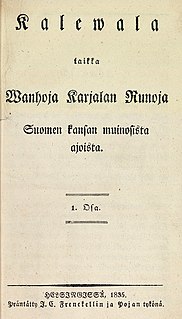
The Kalevala is a 19th-century work of epic poetry compiled by Elias Lönnrot from Karelian and Finnish oral folklore and mythology, telling an epic story about the Creation of the Earth, describing the controversies and retaliatory voyages between the peoples of the land of Kalevala called Väinölä and the land of Pohjola and their various protagonists and antagonists, as well as the construction and robbery of the epic mythical wealth-making machine Sampo.

Zachris Topelius was a Finnish author, poet, journalist, historian, and rector of the University of Helsinki who wrote novels related to Finnish history in Swedish.
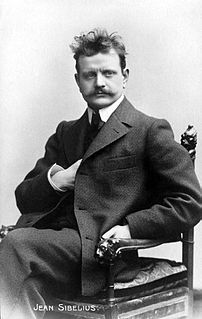
Jean Sibelius was a Finnish composer of the late Romantic and early-modern periods. He is widely regarded as his country's greatest composer, and his music is often credited with having helped Finland develop a national identity during its struggle for independence from Russia.

Akseli Gallen-Kallela was a Finnish painter who is best known for his illustrations of the Kalevala, the Finnish national epic. His work is considered a very important aspect of the Finnish national identity. He changed his name from Gallén to Gallen-Kallela in 1907.
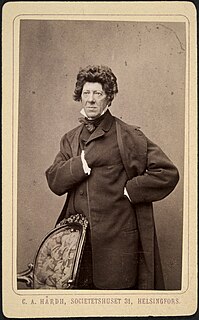
Fredrik Pacius was a German-Finnish composer and conductor who lived most of his life in Finland. He has been called the "Father of Finnish music".

Uuno (Kalervo) Klami was a Finnish composer of the modern period. He is widely recognized as one of the most significant Finnish composers to emerge from the generation that followed Jean Sibelius.
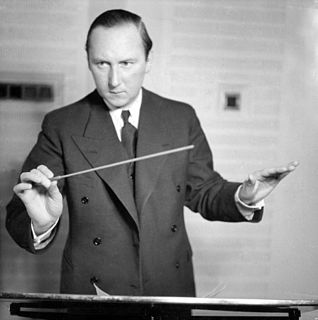
Lars-Erik Vilner Larsson was a Swedish composer known for the lyrical suite God in Disguise, the opera The Princess of Cyprus, and the Pastoral Suite for chamber orchestra. He also composed three symphonies, a sinfonietta, and numerous concertante works.
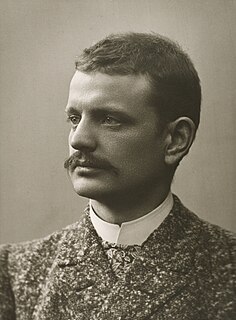
Kullervo, Op. 7, is a five-movement symphonic work for soprano, baritone, male choir, and orchestra written from 1891–1892 by the Finnish composer Jean Sibelius. Movements I, II, and IV are instrumental, whereas III and V feature sung text from Runos XXXV–VI of the Kalevala, Finland's national epic. The piece tells the story of the tragic hero Kullervo, with each movement depicting an episode from his ill-fated life: first, an introduction that establishes the psychology of the titular character; second, a haunting "lullaby with variations" that portrays his unhappy childhood; third, a dramatic dialogue between soloists and chorus in which the hero unknowingly seduces his long-lost sister; fourth, a lively scherzo in which Kullervo seeks redemption on the battlefield; and fifth, a funereal choral finale in which he returns to the spot of his incestuous crime and, guilt-ridden, takes his life by falling on his sword.

Georg Lennart Schnéevoigt was a Finnish conductor and cellist, born in Vyborg, Grand Duchy of Finland, which is now in Russia, to Ernst Schnéevoigt and Rosa Willandt.

The Building of the Boat was a projected Wagnerian opera for soloists, chorus, and orchestra that occupied the Finnish composer Jean Sibelius from 8 July 1893 to late-August 1894, at which point he abandoned the project. The piece was to have been a collaboration with the Finnish author J.H. Erkko, whose libretto adapted Runos VIII and XVI of the Kalevala, Finland's national epic. In the story, the wizard Väinämöinen tries to seduce the moon goddess Kuutar by building a boat with magic; his incantation is missing three words, and he journeys to the underworld of Tuonela to obtain them.
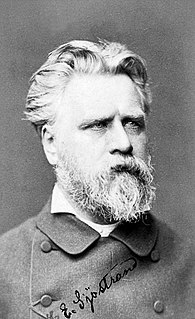
Carl Eneas Sjöstrand was a Swedish sculptor who worked for over 40 years in the Grand Duchy of Finland.
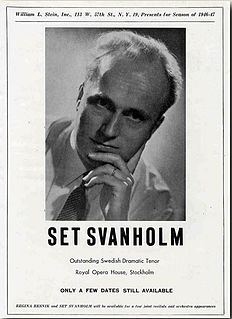
Set Svanholm was a Swedish operatic tenor, considered the leading Tristan and Siegfried of the first decade following World War II.

The Maiden in the Tower, JS 101, is an opera in one act—comprising an overture and eight scenes—written in 1896 by the Finnish composer Jean Sibelius. The piece was a collaboration with the Finnish author Rafael Hertzberg, the Swedish-language libretto of whom tells a "simple tale of chivalry" that may nonetheless have had allegorical ambitions: the Bailiff abducts and imprisons the Maiden ; although she endures hardship, she remains true to herself and is freed subsequently by her Lover and the Chatelaine of the castle.

Drottningen av Golconda is a three-act romantic opera by Franz Berwald, begun in 1863. The libretto was adapted by the composer from one by Vial and Favières intended for Henri Montan Berton; this had been based on another by Michel-Jean Sedaine. Berwald may have known the Berton opera from when he played in the opera orchestra in Stockholm.
Stig Evald Börje Westerberg was a Swedish conductor and pianist, whose career was based mostly in his home country.
Prinsessan av Cypern is a four-act fairy opera by Fredrik Pacius, with a Swedish libretto by Zacharias Topelius. It is sometimes referred to as a singspiel or simply as incidental music to the play.
Herbert Ludwig Sandberg was a Swedish conductor, librettist, and composer of Polish Jewish descent.
Olof Oscar Hemberg was a Swedish newspaper editor, writer and film producer. He has been credited with writing 21 films and producing eight films. Hemberg is best known for writing many screenplays for the director Schamyl Bauman including Witches' Night (1937) starring Gösta Ekman, På Solsidan for Gustaf Molander, starring Ingrid Bergman, and The Girls' Alfred (1935) for Edvin Adolphson, starring Sture Lagerwall. He also wrote the screenplay for the Danish film Idag Begynder Livet for Lau Lauritzen Jr. and Alice O'Fredericks. Furthermore, Hemberg produced several films for Gustaf Molander, including Paresiennes, and His English Wife, as well as Bara en danserska by Olof Molander.

The Pastoral Suite, Op. 19, is a three-movement suite for orchestra written in 1938 by Swedish composer Lars-Erik Larsson. The suite remains not only one of Larsson's most celebrated compositions, but also one of the most frequently performed pieces of Swedish art music. In particular, the Romance (No. 2) is often performed and recorded as a stand-alone concert piece.














